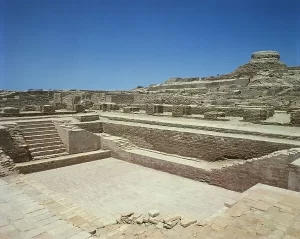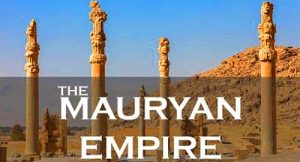Indian History
Table of Contents
Introduction to Indian History
Indian history is a tapestry of ancient civilizations, diverse cultures, and profound legacies that have shaped its identity and influenced global developments over millennia.
1. Ancient India: Birth of Civilizations

1.1 The Indus Valley Civilization
The Indus Valley Civilization, flourishing from 2500-1900 BCE across present-day Pakistan and northwest India, is renowned for its urban planning, advanced drainage systems, and sophisticated trade networks that highlight early urban life and craftsmanship.
1.2 Vedic Period and Early Kingdoms
Following the decline of the Indus Valley Civilization, the Vedic period (1500-500 BCE) witnessed the emergence of Indo-Aryan tribes and the composition of the Rigveda, an ancient Vedic text. This era also marked the rise of early kingdoms known as the Mahajanapadas, laying foundational cultural and social frameworks.
2. Classical India: Empires and Golden Ages
2.1 Maurya Empire and Ashoka’s Rule
Founded by Chandragupta Maurya in 322 BCE, the Maurya Empire expanded significantly under the rule of Emperor Ashoka (268-232 BCE). Ashoka’s conversion to Buddhism after the Kalinga War led to his propagation of Buddhist principles of non-violence and moral conduct through his inscriptions and edicts across the empire.
2.2 Gupta Empire: The Golden Age
The Gupta Empire (320-550 CE) is hailed as India’s “Golden Age,” characterized by remarkable advancements in art, science, mathematics, literature, and philosophy. Scholars like Aryabhata made pioneering contributions to astronomy and mathematics, while literary giants such as Kalidasa enriched Sanskrit literature with timeless works.
3. Medieval India: Dynasties and Cultural Flourishing
3.1 Delhi Sultanate
Established in 1206 CE, the Delhi Sultanate marked the beginning of Muslim rule in India, leaving enduring impacts on architecture, language, and societal norms. Notable rulers like Alauddin Khalji and Muhammad bin Tughlaq shaped the region’s cultural and political landscape.
3.2 Mughal Empire and Cultural Synthesis
The Mughal Empire (1526-1857 CE), founded by Babur, reached its zenith under Akbar the Great. Akbar’s policy of religious tolerance and cultural amalgamation fostered a flourishing period of art, architecture, and literature that blended Persian, Indian, and Central Asian influences. The iconic Taj Mahal stands as a testament to Mughal architectural brilliance and cultural synthesis.
4. Colonial India: The British Raj
4.1 East India Company Rule
The British East India Company established footholds in India in the 17th century, gradually expanding its control over the subcontinent through strategic alliances and military conquests. The Battle of Plassey in 1757 marked a pivotal moment, leading to British dominance and subsequent colonial rule.
4.2 Indian Independence Movement
The 20th century witnessed a fervent struggle for independence led by Mahatma Gandhi, Jawaharlal Nehru, and other prominent leaders. Gandhi’s philosophy of non-violent resistance and civil disobedience, exemplified in movements like the Salt March and Quit India Movement, culminated in India’s independence on August 15, 1947.
5. Modern India: Nation Building and Challenges
5.1 Independence and Partition
India’s independence in 1947 was accompanied by the partition that created India and Pakistan, triggering mass migrations and communal violence. The adoption of a democratic constitution in 1950 laid the foundation for a diverse and pluralistic society.
5.2 Post-Independence India
Since independence, India has navigated various challenges including economic disparities, social inequality, regional conflicts, and environmental issues. However, it has emerged as a global leader in technology, space exploration, and healthcare, reflecting its resilience and potential on the world stage.
Key Events and Influential Figures
6. Contribution of Indian Philosophies
6.1 Buddhism and Jainism
Rooted in ancient India, Buddhism and Jainism espouse principles of non-violence, compassion, and spiritual liberation. These philosophies have profoundly shaped moral and ethical frameworks in Indian society and beyond.
6.2 Influence of Hinduism
Hinduism, the oldest major religion in India, encompasses a wide spectrum of beliefs, rituals, and philosophies that have influenced art, architecture, literature, and societal norms over millennia. Its enduring legacy continues to foster a deep spiritual connection among millions of followers worldwide.
7. Science and Mathematics in Ancient India
7.1 Achievements in Astronomy and Mathematics
Ancient Indian scholars made significant strides in astronomy, with contributions such as Aryabhata’s theories on planetary motion and Varahamihira’s work in astrology. In mathematics, India’s invention of zero and the decimal system revolutionized numerical calculations worldwide.
7.2 Ayurveda and Medicine
Ayurveda, India’s ancient system of medicine, emphasizes holistic healing through herbal remedies, diet, yoga, and meditation. Its principles of balance and natural wellness continue to complement modern medical practices, highlighting India’s traditional healthcare wisdom.
Cultural Heritage and Traditions
8. Art and Architecture
8.1 Ajanta and Ellora Caves
The Ajanta and Ellora Caves, UNESCO World Heritage Sites, showcase exquisite Buddhist, Hindu, and Jain art spanning ancient and medieval periods. These cave complexes depict religious narratives and daily life scenes, illustrating the artistic prowess of ancient Indian civilizations.
8.2 Temple Architecture
Indian temple architecture exemplifies intricate craftsmanship, towering spires (shikharas), and elaborate sculptures dedicated to various deities. Architectural styles vary from the North Indian Nagara to the South Indian Dravidian, reflecting regional aesthetics and religious practices.
9. Literature and Language
9.1 Sanskrit Literature
Sanskrit literature comprises epics like the Mahabharata and Ramayana, philosophical treatises, poetry, and scientific texts that highlight India’s intellectual heritage. Sanskrit remains revered for its linguistic precision and poetic elegance.
9.2 Regional Literature
India’s linguistic diversity has fostered rich regional literatures in languages such as Tamil, Bengali, Telugu, and Urdu. From ancient devotional poetry to modern novels, regional literature reflects cultural diversity and societal evolution across the subcontinent.
Impact of Indian History on the World
10. Spread of Indian Religions and Thought
10.1 Influence on Southeast Asia
Indian religions, particularly Buddhism and Hinduism, spread to Southeast Asia, influencing art, architecture, language, and societal norms. Monuments like Cambodia’s Angkor Wat attest to the enduring cultural diffusion from ancient India to the wider Asian region.
10.2 Globalization of Yoga and Meditation
Yoga and meditation, rooted in ancient Indian spiritual practices, have gained global popularity for promoting physical health, mental well-being, and spiritual growth. Practices such as Hatha Yoga and mindfulness meditation transcend cultural boundaries, resonating with millions worldwide.
Conclusion
India’s history is a testament to its resilience, cultural richness, and global impact across millennia. From ancient marvels to modern achievements, India’s journey unfolds as a narrative of diversity, innovation, and enduring legacy that continues to inspire and influence the world.
FAQs About Indian History
Q 1. What is the oldest civilization in India?
Ans. The Indus Valley Civilization, dating back to around 2500 BCE, stands as one of the earliest known urban civilizations in the Indian subcontinent.
Q 2. Who was Ashoka and why is he significant in Indian history?
Ans. Ashoka, an emperor of the Maurya Dynasty, embraced Buddhism after the Kalinga War and promoted principles of peace and morality through his inscriptions and edicts across his empire.
Q 3. How did the Mughal Empire contribute to Indian culture?
Ans. The Mughal Empire left a lasting legacy on Indian architecture, art, literature, and cuisine, blending Persian, Turkish, and Indian influences to create a unique cultural synthesis.
Q 4. What role did Mahatma Gandhi play in India’s independence movement?
Ans. Mahatma Gandhi led the non-violent civil disobedience movement against British rule, ultimately securing India’s independence on August 15, 1947.
Q 5. What are some famous literary works from ancient India?
Ans. Ancient Indian literature includes epics like the Rigveda, Mahabharata, Ramayana, and the poetic works of Kalidasa, showcasing profound cultural and literary achievements.


